
Coming straight out of Australia, CopterPack is one of the newest personal gadgets that allows its rider to take flight. While jetpacks had their hot moment in the eighties, the CopterPack reimagines how humans can fly using a personal device. Let’s take a deeper look into how this backpack-style personal copter looks and functions.
A reimagined design
Composed of two rotors, the CopterPack is a device that is worn as a backpack and looks somewhat like a human drone. The Australian company of the same name designed the CopterPack much differently from other models in the past. However, there are potentially hazardous elements in this design.
For example, the rotors, while protectively coiled along the edges, are open on the top and bottom. Although this does not pose much of a threat while the pilot is using the CopterPack correctly, it could become dangerous in the event of an accident or other unforeseen circumstance – especially as they operate and spin at high speeds.
How the CopterPack flies
The CopterPack is made with a lightweight, carbon fiber honeycomb design. Rotors on either side of the pilot allow them to fly back and forth on a central axle. The design of the rotors allows the pilot to have a significant amount of control over how they fly.
In addition to what CopterPack claims is an intuitive flight experience, there is an auto-pilot feature that allows the rider to self-level automatically. The carbon fiber used to construct the CopterPack is also used in other aircraft and spacecraft because of its low weight and durability.
Battery powered
While the manufacturers do not provide much detail on the construction or materials used for the battery, it is safe to assume that it is small in size. This is made apparent by the overall size of the CopterPack. Lithium battery packs, like the one used on the CopterPack, are known to have poor energy density.
Because of this, pilots likely won’t be able to spend much time in the air. Their weight, coupled with the power needed to propel the high-speed spin of the rotors, requires a great deal of energy to operate for a more substantial amount of time.
The rotors
The power and stability of the CopterPack are generated by its two large rotors. Each of the two rotors on the CopterPack reaches about three feet in diameter. It is assumed that each of these connects to the unit through carbon fiber tubes. To allow the pilot to steer, the rotors are directed by two hand controls on two armrests that connect to the pack. To achieve control and stability, the pilot can rely on the CopterPack’s ability to twist its rotors and vector the thrust.
Final thoughts
The CopterPack looks to be constructed with quality design and materials, and the flight itself is very impressive. We will update you as and when we get more information from CopterPack.

Startup
A startup or start-up is a company or project undertaken by an entrepreneur to seek, develop, and validate a scalable business model. While entrepreneurship refers to all new businesses, including self-employment and businesses that never intend to become registered, startups refer to new businesses that intend to grow large beyond the solo founder. At the beginning, startups face high uncertainty and have high rates of failure, but a minority of them do go on to be successful and influential. Some startups become unicorns; that is privately held startup companies valued at over US$1 billion.
Actions
Startups typically begin by a founder (solo-founder) or co-founders who have a way to solve a problem. The founder of a startup will begin market validation by problem interview, solution interview, and building a minimum viable product (MVP), i.e. a prototype, to develop and validate their business models. The startup process can take a long period of time (by some estimates, three years or longer), and hence sustaining effort is required. Over the long term, sustaining effort is especially challenging because of the high failure rates and uncertain outcomes. Having a business plan in place outlines what to do and how to plan and achieve an idea in the future. Typically, these plans outline the first 3 to 5 years of your business strategy.
Design principles
Models behind startups presenting as ventures are usually associated with design science. Design science uses design principles considered to be a coherent set of normative ideas and propositions to design and construct the company's backbone. For example, one of the initial design principles is "affordable loss".
- Log in to post comments